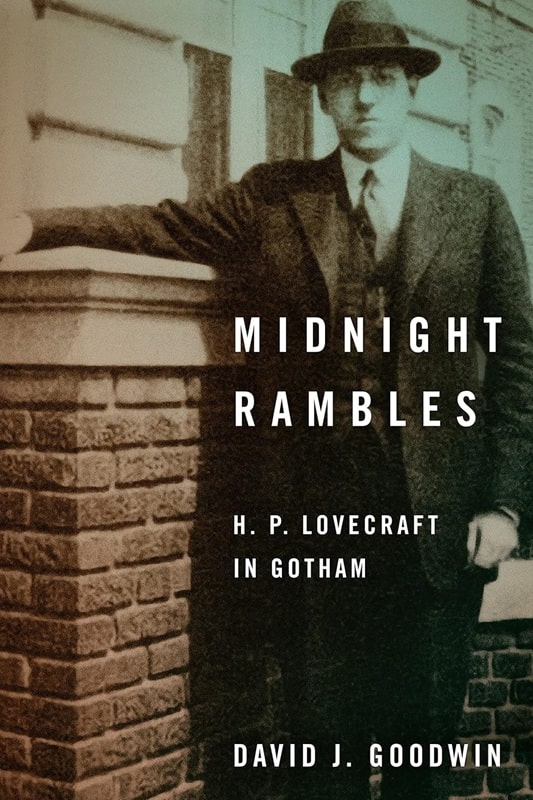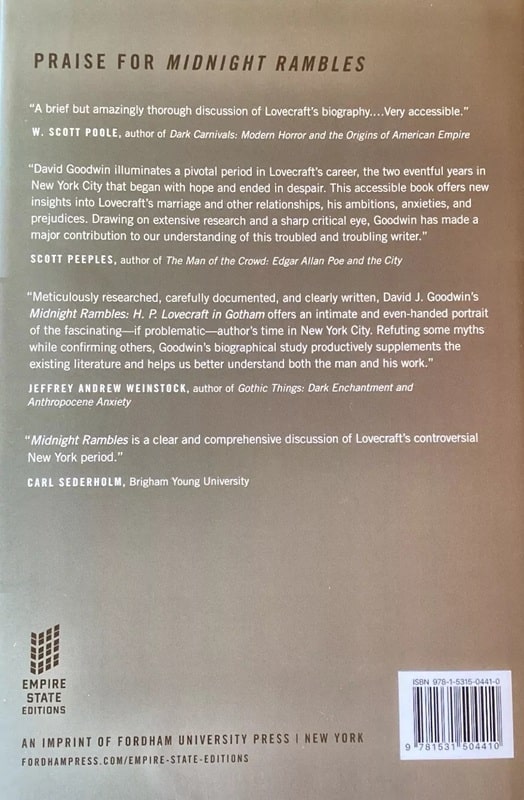Midnight Rambles: H.P. Lovecraft in Gotham by David J. Goodwin
 |
 |
Midnight Rambles: H.P. Lovecraft in Gotham (Empire State Editions, November 7, 2023)
David J. Goodwin’s Midnight Rambles: H.P. Lovecraft in Gotham provides a narrow and deep slice of H. P. Lovecraft’s biography, detailing his personal and professional life during the few years he lived in New York City. Deeply researched and full of connections, Goodwin provides correction to some long-held Lovecraft biographical details and does not flinch from detailing Lovecraft’s innate hostility to non-WASP groups, ably describing it in the context of a deeply racist and anti-semitic society.
There are very few people who can claim to be expert on the life and work of H.P. Lovecraft, and Goodwin’s book puts him in range of that small number (such as S.T. Joshi). As he’s written and presented about Lovecraft more than half a dozen times, Goodwin seems poised to rise to stand among the critics named when the storied and controversial author rises in conversation, if he’s not there already. Learn more about Goodwin here.
Goodwin faces a difficult biographical subject in writer H.P. Lovecraft. Much material of signal importance during this time is unavailable. His spouse, Sonia Greene, destroyed some 400 of Lovecraft’s letters, largely from the period of interest for this text. Lovecraft’s aunts, demonstrably hostile to his marriage to Greene, discarded dozens of postcards when Lovecraft moved to New York through the simple expedient of giving away everything he had not specifically requested be sent to his new lodgings in the city. These details sample the rich trove of information about Lovecraft in Goodwin’s text.
Despite these holes in the biographical record, Goodwin’s ample research buttresses his assertions about the writer’s experiences in Gotham. The period constitutes a fertile time for Lovecraft, a locus that saw the invention of what would later be called the Cthulhu mythos. That it also saw the creation of the author’s least palatable, racist fiction represents an unavoidable truth. For each of the Lovecraft stories written during his residence in the city, Goodwin provides detailed research that helps illuminate the influences likely to have pressed upon the author. However, the biographer also includes historical demographic information to fully contextualize the lack of basis for any of Lovecraft’s many claims, a thread illustrating Lovecraft’s self-mythologizing nature.
The architecture of houses, the urban design of towns and cities was always of interest to Lovecraft, who, Goodwin explains, ambled extraordinary distances to view places and structures of interest. Readers familiar with John Crowley’s Little, Big may notice a reference to a real life builder important to New York that appears in that fictional text.
Lovecraft’s relationship with Sonia Greene merits several chapters and encapsulates their meeting, courtship, sudden marriage, and ultimate divorce that neatly marks the end of Lovecraft’s time in the city. Goodwin works wonders with the limited material available on this window to the past and readers familiar with Lovecraft biographies of broader scope will find material of interest in these pages. It is here Goodwin provides the price of admission for this text. Owing to an absence of a signed decree of divorce, past biographers have stated the author failed to sign those papers, meaning Greene’s subsequent marriage in California was bigamous.
Goodwin effectively implodes this “never signed” myth with solid evidence to the contrary, noting in addition that the loss of legal documentation was not uncommon in the 1920s. This conclusion is an exception among many assertions buttressed with the language of guesswork. Of all the guesses in Midnight Rambles, none struck this reviewer as unlikely or a reach. The biographer confines himself to likely scenarios, allowing for the many connections to form a compelling web to wrap these Lovecraft years for readers.
Readers interested in Lovecraft will find Midnight Rambles required reading. In this readable and at the same time admirably academic work (the two do not always meet amicably) even casual readers of Lovecraft may find information of interest. While Lovecraft expressed vehement racist and anti-semitic views, he married a Jew. While holding typical for the era dislike for homosexuals, one of his New York City walking buddies and long time correspondent was gay. Understanding this author, who some say serves as the pennant-waver for American horror fiction in sequence after Edgar Allan Poe, is made easier by Goodwin’s work. I recommend it to Lovecraft enthusiasts and any who find interest in the literary history of Gotham, our style and fashion capital.
Edward Carmien’s last article for Black Gate was When Your First Language is Role-Playing Games. His short stories “Before the Wind” and “Knives Under the Spring Moon” appeared in the print version on Black Gate in 2007 and 2008. He maintains a daily blog on writing at edwardcarmien.wordpress.com
Having worked in Brooklyn Heights and wandered over to Red Hook on occasion, I often wonder just what bothered HPL so much about the neighborhood that he found it a natural setting for horror. I should give Mr. Goodwin’s book a solid perusal. Sadly, we seem to have witnessed HPL’s reputation collapse in on itself due to his prejudice and fears that fed his stories. So I probably would not get the monthly sf/f reading group interested. They were OK with At the Mountains of Madness, but the rest of HPL’s baggage would likely be too heavy for them to bear.
Everybody has likes and dislikes, but I personally would not want to be part of a reading group that can’t see good art due to an artist’s “baggage” or his supposed “toxicity”.
Eugene,
I suggest not shying away from Lovecraft. Read in context, he’s a part of our literary history. Writers like Fitzgerald and Hemingway present work equally if less obviously problematic. Consider _The Great Gatsby_ in this context, a work with broad thematic similarities to some of Lovecraft’s stuff. As for what HPL saw in Red Hook that triggered his most racist work? Poverty. Crowds of non-WASPs. Goodwin does a great job suggesting an answer to your question….
Failte, Ed,
I agree with you on HPL’s standing in our genres (sf/f/horror) and within more general Literature. He does have Library of America editions of his works. And I was happy to get the monthly gang to read At the Mountains of Madness, which I liked most of his novels. But it is a struggle and not made easier as we get more aware of the toxicity in some of his writing (along with the joy and sense of wonder -> Ruthanna Emrys and Anne Pillsworth did a fantastic job “reading” HPL over on reactormag.com, Tor Books’ blogsite). He does share that baggage with other contemporaneous writers, true. Just goes to show how much work we need to do! Who says sf/f/horror is easy escapism, right?
And it sounds like his Red Hook was not too different from mine in the 1980s and ’90s. Guess he was less interested in finding the building with train tracks running through one of its corners (due to the use of trains to unload cargo at the docks and then navigate the narrow streets).
[…] Midnight Rambles: H.P. Lovecraft in Gotham by David J. Goodwin […]
A lot of people, it seems to me, want art to be a mirror rather than a window. That’s their prerogative, of course. Me, I already have a mirror in my bathroom.